Chapter 4
FORMAL EDUCATION PROGRAMMES AND INSTITUTIONS
SATHYA SAI SCHOOLS
Table of contents return to Front page
Sathya Sai Schools
Introduction
Sathya Sai Schools in India
Sathya Sai Schools outside India
School Climate and Its Transformative
Effect on Students
Effect of Students' Transformation on Parents
Effect on the School Staff
A Day at the School
Relationship of Sathya Sai School Philosophy,
Guiding Principles and
Values to School
Climate of Peace and Love
Difference from Other Schools
School Governance
Sathya Sai School Community
Teacher Training and Teaching Resources
Institutes of Sathya Sai Education (ISSEs)
Introduction
Establishment of Institutes outside India
Functions of ISSE
Establishment and Management of Sathya
Sai Schools
Training of Teachers
Partnerships in SSEHV in a Whole School Approach
Training of Teachers through Affiliations
with Colleges, Universities, and Ministry
of Education
ISSE as a Resource of SSEHV Material
Role of ISSE in Programme Development
and Research
Sri Sathya Sai International Centre for
Human Values
References
Introduction
An introduction to Sathya Sai Schools is given in Chapter 2. This chapter describes the implementation of Sathya Sai Education in these schools around the world, frequently in the words of teachers, parents, and students.
Sathya Sai Schools operate in different parts of the world under diverse ethnic, religious, and cultural settings. This diversity is respected in all school activities. For example, prayers and devotional singing reflective of the religions of the students are included in the school day. Songs and prayers reflect the predominantly Christian School community at the Sathya Sai Schools of Zambia. At the Sathya Sai School in Thailand, the devotional aspect of the school day reflects the Buddhist background of its students.The medium of instruction is Thai at the Thailand School and English in Zambia. Teachers are certified by local governmental jurisdictions and most teachers are native to the country of school location.
A school should not be considered just a common place arrangement designed for teaching and learning. It is the place where the consciousness is aroused and illumined, purified and strengthened, the place where the seeds of discipline, duty and devotion are planted and fostered into fruition.
Sathya Sai Schools in India
As of August 2006, there were over 70 Sathya Sai Schools spread throughout India with an enrolment exceeding 16,000 students and 700 teachers. In Prasanthi Nilayam, there is a full-fledged residential Primary and Secondary School (from Class I to Class XII), affiliated to the Central Board of Secondary Education, New Delhi. The school prepares students for the Secondary and Senior Secondary Certificate Examination of the Board. Children in the school receive direct guidance from Sri Sathya Sai Baba. Other Sathya Sai Schools in India receive academic guidance from the Institute of Sathya Sai Education at Dharmashektra in Mumbai.
Two other Sathya Sai Schools, the Sri Sathya Sai Loka Seva School in Alike, Karnataka State, and the school at the Sri Sathya Sai Deenajanoddharana Pathakam (Project for destitute children) in Andhra Pradesh are well known throughout India.
Sri Sathya Sai Baba himself has visited these schools and he devotes personal attention to the students' well being.
The Sathya Sai School in Alike came under the network of Sathya Sai Schools in 1978 when Sri Sathya Sai Baba visited the school.The school is primarily residential with a hostel for the students. A junior college was established in Alike in 1972. All activities in these educational institutions are permeated by the five human values that are the foundation of the Sathya Sai Education System. In 2005 the junior college students recorded a 100 per cent success in the state examinations. The results were also good in the state placement examinations for engineering and medical schools. A fully residential secondary school for boys was established in Alike in 1984. Most students are residents with a few coming as day scholars from nearby villages. The school complex also includes an orphanage that houses 100 destitute children and a General Hospital that provides free medical care.
In June 2002, Sri Sathya Sai Baba established the Sri Sathya Sai Deenajanoddharana Pathakam, to house single mothers and boys from nearby villages. This is a residential facility located adjacent to Prasanthi Nilayam. A trust fund has been established to support and educate boys until they get a job after postsecondary school graduation. Sixty boys and twelve mothers accepted the temporary accommodation in Prasanthi Nilayam, and within a year a permanent building complex with private rooms was built nearby as a home for them. Within two months eight new classrooms were built for the boys at the home.
The boys attend classes and follow a daily routine: wake up at 4:30 a.m., do prayers, go jogging, attend classes, lunch and rest, then return to class; Bal Vikas class at 4:30 p.m.; then play on their own spacious playground. After dinner they attend to homework and then turn in to bed after prayers. Arrangements are made for the older boys to take placement examinations in mathematics and accountancy for public colleges. Occasionally, Sri Sathya Sai Baba visits the home and school and gives personal attention to the boys.
Sathya Sai Schools outside India
Forty-one Sathya Sai Schools, with about 5,100 students, currently operate in 26 countries outside India. Many Sathya Sai Schools outside India serve primary grade students, having begun operation in the late 1990s.
The growth in the Sathya Sai School in Australia is typical of many Sathya Sai Schools around the world. A new Sathya Sai School opens at the primary level. They add a new grade every year, with the senior students moving to the next class level. In this way, the school progressively reaches the secondary level over time.
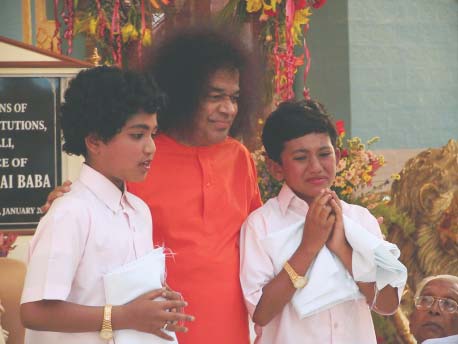
Sri Sathya Sai Baba walked slowly to a boy and offered a fruit himself. "What do you want?" Sri Sathya Sai Baba said. "Chaduvu (education)," the boy answered. Everyone was pleasantly surprised. "I will arrange that," promised Sri Sathya Sai Baba, who asked again, "What more do you want?" "Nothing, except education," the boy answered.
—Sri Sathya Sai Baba speaking to a student
of Deenajanoddharana Pathakam
At the outset, we fell for the excellent food we were having for the first time in our life. Today we realise the more valuable things we receive here — motherly love and affection, good bringing up in value system and quality education tempered with spirituality. I do not know how many among the millions of contemporary students in the country are that lucky.
—A Boy from Sri Sathya Sai
Deenajanoddharana Pathakam
School Climate and Its Transformative
Effect on Students
The school climate at Sathya Sai Schools is peaceful, loving, and invigorative. This is observed by a wide variety of people including Education Ministry officials on accreditation visits, local government officials, parents, teachers, principals, and the students themselves.
The universal aspect of human values promoted by the Sathya Sai Schools is evident in the frequent anecdotal evidence of their wide appeal. This is as reported from Sathya Sai Schools in countries quite different from one another in religion, race, culture, and politics. The reports from Sathya Sai Schools around the world echo the same themes of peace and happiness in the school climate.
Thailand
The SAI 2000 inspection report of a residential Sathya Sai School illustrates an atmosphere suffused with human values from the start of the day.
- A typical school day begins with the early morning gathering of all students and staff at 5:45 a.m. in a large and spacious Prayer Room where the early morning prayers and meditation set the mood and objective for the day. Students tip-toe to their designated places, and silently wait for the prayers and meditation to begin. Student leaders start the prayers, which are multidenominational. This is followed by a short discourse by the Headmaster on the topic for the day. The students then reverentially get up and leave for their breakfast at 6 a.m. The flag-raising ceremony begins at 7:20 a.m. at the open, concrete quadrangle outside the gymnasium. Lined up in neat rows, the students show respect and honour to the nation by singing the national anthem as the national flag is raised to the full mast. Again, there is a short address to the assembly by the Headmaster on the importance of loving the nation - the motherland.
- Formal classes begin at 7.40 a.m. with a definite focus on education in human values (SSEHV) as the first lesson of the day. Everywhere there is a happy expression of the age-old Thai custom of respect for one another, the elders, and the teachers. The instant expression of the Thai salutation of clasping the hands in prayer as a form of greeting and speaking softly in the melodious Thai language permeates the entire school atmosphere.
Of particular importance is the strong and profound leadership of the school Headmaster who gets unflinching support from everyone directly or indirectly involved in the school. In fact, what many parents, teachers, and students like most about the school is the Headmaster. This exemplary leadership of "Living by example" is his motto. "Give the children all the love you can, and they will change." This profound belief of the Headmaster is gradually having a great impact on the teachers. One of the most conspicuous things was that students felt very relaxed and participated actively.
Zambia
The Sathya Sai School principal describes the beginning of the school day:
- Sunrise in the environs of Sathya Sai School is a beauty to behold. By 6:45 a.m., students from different corners of the township start trooping into the school compound, full of vigour and energy; their faces beam with the radiance of the sun.
- By 6:55 a.m. all students are fully seated in the Sathya Sai Auditorium for the morning assembly which begins at 7:00 a.m. Prayer Sessions are conducted with local songs to the beat and rhythm of traditional drums.
- After the morning assemblies, the students disperse to their respective classrooms for a 40-minute class in SSEHV. Thereafter, the normal classes begin.
Paraguay
The climate in Sathya Sai Schools is one of emerging human values as seen in the behaviour and speech of students.This also has a transformative effect on other students and families. A staff member writes:
- The overall environment is very happy and peaceful.
- The children sing Human Value songs and the parents often comment that our students are wonderful instruments at home, because they gently correct their siblings.
- In some cases, it has an effect even on their parents by reminding them to follow Nonviolence and speak the Truth.
- A second grader, when she heard her classmate use a bad word, said, "Don't use bad words, they will hurt your ears," and she covered her ears. The classmate has stopped using bad words, and reminds his classmates to use only good words.
Chile
A Sathya Sai School official says:
- The parents testify of great changes in their homes; the children behave as seen nowhere else except in another Sathya Sai School.
- The adults involved see that their lives change every day; fortitude, compassion, respect, joy, and other great things happen in small increments, but after some while the changes of attitude can be noticed by anybody who knew the child before.
Mexico
From a Sathya Sai School official:
- During several opportunities parents have expressed their joy when their children want to go to our school. In the past, their kids were reluctant and now they want to be the first to arrive to the classroom.
- Parents have noted and sometimes been surprised by the behavioural changes in their children. "What are you doing with my kid? He's different now." This is one of the most common expressions we hear.
Ecuador
From Guayaquil, the Sathya Sai School principal eloquently describes the school climate:
- Only to bring Sri Sathya Sai Baba into this school constitutes the greatest experience. The reigning silence interrupted by the singing of the children; the total cleanliness; the order of the facilities; the beauty of the gardens; the self-discipline of the children; the self-confidence that they demonstrate in each of their declarations; the respect for themselves and for the others; the love for this school, family, city, country, planet, and humanity; the gratitude to the Creator; the happiness reflected in the faces of the children; the satisfaction for duty fulfilled with love, reflected in the faces of the teachers; I believe that all these say much about the climate of this school.
- All the persons who visit the School, without exception, recognise that the climate of this place is special; that here one breathes an ambience of peace, harmony, and happiness. Some of them have catalogued it as "a paradise", "an oasis", "incredible", and so on.
New Zealand
The principal from the Sathya Sai School reports:
- The children respond readily to the love and value-based method of delivery which bring out the inherent values in them. Those visiting the school comment on the underlying atmosphere of love, which permeates the teaching provided.
- There are many examples of children who enter the school with negative behavioural traits, which are quickly remedied. The children in the classes have developed a culture of care and consideration, which emulates the role modelling of the teachers.
- Bad behaviour just does not resonate with this culture and new children quickly adjust themselves to the behaviour of their peers.
Venezuela
The principal from the Sathya Sai School reports:
- Every day, our school provides gratis a cooked breakfast, a mid-morning snack, and lunch, to all students. Sometimes parents and friends come along to help prepare them.
- Medical and dental assistance, shoes, socks, underwear, comb, toothbrush, pants, shirts, books, notebooks, and school insurance are all provided free of cost.
Brazil
In some neighborhoods, parents and children gain a sense of safety and security at the Sathya Sai School. At the Sathya Sai School of Vila Isabel the principal reports:
- The Sathya Sai School climate is so good that former students spontaneously visit the school and declare that they couldn't find other places like that, so loving and peaceful.
- On account of this, we are experiencing a remarkable return of teen youth (former students), to attend a special programme developed for them, which is the Computer Class (with human values) maintained by the Sai Youth of Brazil. Those classes are offered in the premises of the Sathya Sai School of Vila Isabel.
- Living in a violent slum environment, the parents frequently declare that "they are in paradise" in the school premises. They feel protected there.
At the Vila Isabel Sathya Sai School, there are psychologists, medical doctors, and dentists who voluntarily give additional support to the children and their families. The children live in a violent environment where they are exposed to many kinds of abuse in the community at large or even at home. The psychological support provides an invaluable aid to cope with this unfavourable reality. The medical support works at preventive level with lectures on health and hygiene, but also offers clinical services to the students and their families.
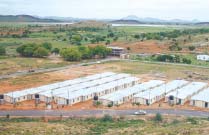
'Educare', that is, Education based on Human Values, is yet another example of Bhagawan Sri Sathya Sai Baba's deep commitment to the all-round development of all people, in particular our children, who are the future of our nation and of humanity. Bhagawan's profound understanding of the art and science of education has given him the insight into converting syllabus and textbook-bound education into holistic "Educare" that involves both teachers and parents and gives them joy as well as the responsibility in developing children's potential. … Truly, the philosophy and practice of 'Educare' needs to be integrated into the general system of education in India for our national regeneration.
—Atal Bihari Bajpayee, the then
Prime Minister of India
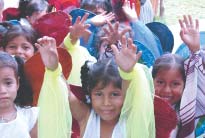
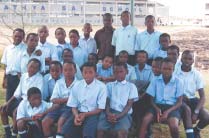

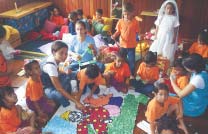
Effect of Students' Transformation on Parents and Others
There are frequent reports from Sathya Sai School staff that the effect of students' transformation extends to affect parents positively.
Equador
The principal of the Sathya Sai School in Bahia de Caraquez, reports that parents find their children more self-disciplined since they started attending the school, "Parents say to us the children get up early in the morning to study daily lessons, and they do their duties without being told. They alone know what they must do, how and when."
Thailand
The Sathya Sai School inspection report captures comments made by parents pleased with the changes occurring with their children's attendance at the school, and especially pleased at the fostering of respect for Thai culture.
- Interviews were conducted at the school over a three-day period. A total of 13 parents were interviewed.
- Parents exhibited a consistent response to the questions on whether they had seen any changes in their children. "Our children are happy." This was the message that came across clearly. They are "calm and kind to other people."
- There have been a lot of positive changes. "My child is more open and shares things with others." When the children are home for the vacation or the weekends, some of them get into the routine of doing things that are done in the school: saying their prayers in the morning; observing the prayers before partaking food. Above all, they are very polite and observe the Thai salutations and the Thai form of salutation "Sawasdee" without any reservations. "They practise real Thai culture."
United Kingdom
This description of school children's exemplary influence on the parents comes from a Sathya Sai School:
- With the Sathya Sai School in Leicester, some parents have mentioned changes in their lives: such as waking up earlier because children want to come to school early; saying prayers before eating; eating healthier food; calming down due to practise of silent sitting or light meditation at home; cutting down on things (ceiling on desires); doing exercise with children and keeping fitter.
Canada
Parents report a genuinely positive influence on them by their own children in the Sathya Sai School of Toronto:
- My child is now more responsible and considerate. He is now learning to differentiate between right and wrong. He collects money for poor children by baby-sitting his little cousin for the weekends. If I happen to raise my voice, he says it is not nice to yell or scream [and that one should] speak softly.
A staff member of the Sathya Sai School of Toronto, describes the influence of Sathya Sai School children on the surrounding community,
- The local librarian whose library our students have been using for the past four years insisted that the school hold one of its parent meetings at the library so that she could tell them herself how different their children are in behaviour from public school children.
- Their keen sense of engagement, discipline, and public speaking skills endear them to people wherever they go. They have addressed rallies and assemblies about the place of the five human values in their lives. These included an inter-faith prayer meeting; a welcome dinner for a Nobel Peace Prize winner; and various other community forums.The importance of human values was discussed also with law enforcement officers.
The Philippines
From the Sathya Sai School comes this comment:
- Parents have voiced their support saying that now children ask them to watch less TV, ask them not to smoke or use abusive language at home.
- Several episodes of transformation can be heard during the active Parent-Teacher meetings and community programmes.
Taiwan
At a parent workshop to increase understanding of the human values education that their children were receiving at the Sathya Sai School, some parents commented on the transformation in their children:
- One mother: I have been silent and dared not to speak because I might burst into tears as soon as I open my mouth. I appreciate all that you have done for him. My son was short-tempered and he fought with others all the time. Because of your love, he has improved a lot. I envy my son, because I am a victim of harmful education, it takes a lot of time to repair the wounds. My son had already registered somewhere else before coming to this school. Fortunately, I have made the right decision.
- Another mother: I really appreciate what you have done for my little boy. I was deeply moved when I once heard him read, "Let me learn to listen to others, not only because they might be wiser than me, but also because they love me." My son demands quite a lot of himself - he was short-tempered and tended to get angry easily. After he learned this quotation, "let me learn not to get angry, even if someone irritates me," from school, he changed totally. I remember once we were at a friend's house. He was angry when I asked him to go home because he was having fun. I said it is not right to be angry and then walked away. It was unbelievable that he came to me to apologise. It had never happened before.
Venezuela
As reported by the Sathya Sai School, love for one's own religion and culture is fostered by providing regular assistance to the local Church, so that as Christians, the students learn to love their Catholic religion. The School promotes cultural activities to uphold the local traditions and culture and the beauty of the school and region.
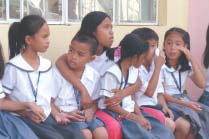

Effect on the School Staff
The predominant feeling of peace and love in the school climate has a positive effect on staff morale and on school attendance.
Argentina
The Sathya Sai School reports:
- The teaching team is solidly in place over time in contrast to other typical schools in the area where the teaching body rotates often from one school to another.
- Student attendance is much better than at nearby public schools, and that the waiting list of students seeking enrolment in the Sathya Sai School is 170. The climate is similar in other Sathya Sai Schools.
Australia
An official of the Sathya Sai School summarises the effect on the staff:
- Teachers see teaching as a calling, their own spiritual path ... about self transformation not just information.
- Educare promotes professionalism and modelling of the five human values at all levels, thus inspiring teaching and leadership skills.
- The school is perceived as a school advancing spirituality infused into all domains of the human personality. It is not about religion.
Chile
A Sathya Sai School staff member reports:
- Our environment is "scream/noise free"
- We do not punish the children. Everything is done with the reasoning of love. This is so revolutionary, yet so effective, that it makes a unique experience for all, including hardened professionals visiting; they comment on how moving this is.
Ecuador
The principal from the Sathya Sai School in Guayaquil, reports:
- When new teachers arrive they are all professionals in education.
- At the Sathya Sai School, they receive training in SSEHV, and their transformation begins.
- They discover that they are capable of achieving excellence, and they themselves are astonished having discovered all the workmanship and skills that had been asleep that the Sathya Sai School manages to wake up.
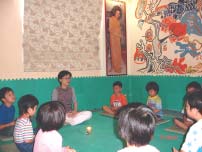
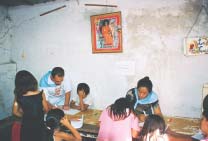
A Day at the School
Most Sathya Sai Schools are non-residential. Children daily walk or ride to the school and return home in the afternoon.
United Kingdom
Given here is an example of a typical school day in a Sathya Sai School:
- A day in the life of the Sathya Sai Schools begins with children arriving at 8 a.m. They go to their respective classes to sort out their homework and wait to hear the music. Then they head for the prayers area. They sit quietly and prepare for prayers. The school prayer is recited and group devotional songs are sung. These are mainly in English and universal. After the group devotional singing, a different prayer is recited daily to close the assembly. Children greet all the members of staff.
- The students head for SSEHV class from 8.30 a.m. until 9 a.m. Normal lessons follow. There is a fruit break at 10 a.m. There are classes again until lunch at 12.45 p.m. At lunch the food prayer is recited and the children eat in silence. Lessons follow from 1.15 p.m. to 2.45 p.m. after which they meet for afternoon prayers.
The elements of universal prayer or meditation are common in Sathya Sai Schools, all of which are open to children of all faiths and cultures. Prayers promote positive thinking, self-confidence, inner tranquillity, and humility.
Residential Sathya Sai Schools are relatively fewer in number than non-residential Sathya Sai Schools. The influences of the integration of spirituality with character development are seen in the orderly schedule before and after classes.
Nepal
In the daily schedule of the Sathya Sai Shiksha Sadan, students come from all parts of the country. Sadan has students from 44 districts out of 75 districts in Nepal. Only 20 per cent students are from Sai families.
| 05:00 | Rising up and prayer |
| 05:30-06:00 | Prayers and meditation |
| 06:00-07:00 | Physical fitness exercises |
| 07:00-07:15 | Snacks/milk |
| 07:15-08:20 | Silent sitting/music, supervised study |
| 08:20 | Breakfast |
| 09:00-16:00 | School hours, lunch, siesta, |
| light refreshment | |
| 16:00-17:30 | Games/free time |
| 18:00-18:30 | Prayers and meditation |
| 18:30-19:00 | Dinner |
| 19:00-20:30 | Study hours |
| 20:30 | Hot drinks |
| 21:00-22:00 | Reading for pleasure (optional) |
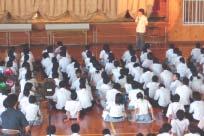
The Relationship of Sathya Sai School Philosophy, Guiding Principles,
and Values to School Climate of Peace and Love
The philosophy, goals, and values of all Sathya Sai Education programmes are fully described in Chapters 1 and 2. The Institutes of Sathya Sai Education (ISSEs) support the Educare philosophy, goals, and values and train Sathya Sai School teachers in infusing human values into their instruction of students. Here, a brief summary of typical Sathya Sai Schools' philosophy, norms, and values illustrates the relationship between the application in a school setting of the underlying principles of the Educare and a school climate infused with peace and love.
Mexico
The philosophy of the Sathya Sai Schools is stated as follows.
- A Sathya Sai School is an educational centre with a unique mission: the integral development of the child's character through a programme that promotes the human values experience in all the school aspects.
- The school's norms read, "Every single activity in the school is directly based upon the Sathya Sai Human Values programme, a system that is inclusive and non-religious, based on the five universal human qualities: truth, right conduct, peace, love and nonviolence."
- The school's values read, "Human values are promoted through human values weekly lessons; a Public Education Ministry approved programme is taught but with a human values approach."
- Educare is practiced as self-inquiry and a non-judgemental outlook; meditation with light; Universal prayers; Support activities to reinforce human values, such as festivals, theatrical plays, community service projects.
- Discipline is a most important issue, so respect and tolerance for other's opinions and beliefs is prevalent.
United Kingdom
The philosophy and vision of the Sathya Sai Schools are stated as follows:
- Sathya Sai School is a place of serenity and orderliness.
- The principal strength of the school is the belief that education is about God and His creation. As such the school is God-centred.
- SSEHV is the breath of the school. The values of Love, Truth, Peace, Right Conduct and Nonviolence form the pillars of the school. It is the pivot upon which the school's professionalism and ethos revolve.
Venezuela
The vision and philosophy of Sathya Sai School read:
- The school should not only be a place to impart academic knowledge, but also a place to provide a context for understanding oneself and the world at large.
- The formal curriculum alone will not change the character of children and bring out the values within. Therefore this school endeavours to provide a nurturing environment that will cultivate the best human qualities in the children and make these qualities manifest in their lives.
- The human values are also taught indirectly through the academic curriculum, where ethical behaviour is emphasized in the examples, literature, and activities of each subject. The values are also enhanced in the classroom management, playground activities and in the way the students and teachers interact throughout the day.

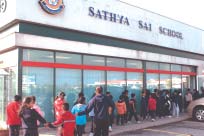
Difference from Other Schools
Nepal
As described by a Sathya Sai School principal: The Sathya Sai School (Shiksha Sadan) provides modern education in a spiritual environment. This makes the school different from other private schools in the country.
Venezuela
The principal at the Sathya Sai School lists the following factors as contributing to the difference between the Sathya Sai School and other schools:
- It is Sri Sathya Sai Baba’s mission, and his blessing.
- The learning environment is impregnated with love.
- We apply the SSEHV methodology.
- We have special commitment to the spiritual path.
- We are oriented to Human and Academic Excellence.
- The Sathya Sai students in our school achieve outstanding level of human and academic excellence.
- Beyond the methodology lies the fundamental inspiration and driving force, love. Along with the methodology, it is love that sets the school apart from others. After many visits from outside teachers and educationists, we can safely say that none leave the school untouched.
Zambia
A Sathya Sai School official describes the difference succinctly:
- Sathya Sai Schools aim at character transformation.
- Effort is made to elicit human values from the subjects that are taught and these values are then integrated into the school curriculum and applied to life.
Reports of Sathya Sai Schools exceeding their respective national curriculum assessment standards and their being viewed by public education officials as model schools are common. Examples include Sathya Sai Schools of Toronto,Zambia, Thailand, The Philippines, Peru, and New Zealand.
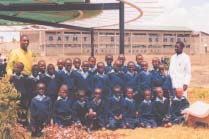
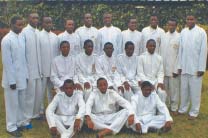
School Governance
There are three types of school governance structures that have emerged within the worldwide Sathya Sai School initiative. These governance structures can be categorised as school governing boards, Institutes of Sathya Sai Education, and Sathya Sai Education Trusts.
Where school governing boards exist, members of the governing board are typically selected by Sri Sathya Sai Organisation officials at the national or international area level and are a combination of education professionals, lawyers, and professionals with business backgrounds. A governing board makes final decisions regarding school budget, hiring of staff, adopting school policy, purchase or lease of facilities, and adopting textbooks and materials. Recommendations to the school governing board are typically made by the school principal or lead teachers. A school board is usually not involved in identifying funds needed for school operation. Rather it is concerned with conscientious stewardship of funds, materials, facilities, and personnel in order to promote the harmonious operation of the school.
The second governance structure type within the Sathya Sai School movement is the Institute of Sathya Sai Education (ISSE). For some Sathya Sai Schools, for example, those in Australia and Latin America, the ISSE has emerged not only as the provider of instructional training, but also the entity that has the primary governance role over the Sathya Sai School. A description of the ISSEs is given in a separate section below. In a school governance role the ISSE assumes many or all of the functions of a school governing board in providing stewardship of school resources and personnel.
The third type of governance structure utilised for some Sathya Sai Schools is a Sathya Sai Education Trust, usually at the national level. Education Trusts are established to identify and obtain funding for school operation in a discrete manner that avoids solicitation. While Sathya Sai Education Trusts are functioning in many countries, they have taken on school governance roles in Zambia, Ecuador, Venezuela, Peru, Paraguay, and Kenya, for example. Officials within the Sri Sathya Sai Organisation typically serve on the Education Trust. In addition to the funding role, when an Education Trust takes on a school governance role, it assumes many or all of the functions of a school governing board in providing stewardship of school resources and personnel.
Examples of governance structures as of summer, 2006, include 13 schools governed by a trust only. Four were managed by a governing board structure only, four governed by their ISSE only, three governed by local or national Sri Sathya Sai Organisation structure only, and seven by a combination governing structure involving the ISSE and a trust or governing board.
School site decision-making varies but typically involves a school site level committee.
Zambia
Administration is decentralised, and each school has its micro-administration headed by the Principal.
United Kingdom
One Sathya Sai School is managed by a Board of Governors, comprising the Sri Sathya Sai Organisation Regional Chair and National Schools Coordinator, an educationist, a lawyer, an accountant, the Sri Sathya Sai Organisation Central Coordinator, and a Teacher Governor.
Brazil
The five Sathya Sai Schools have been assigned an SSEHV Board representative by the ISSE.The Board representative is responsible for the follow-up of all activities in the school. In some few cases, they actually may enforce changes in the work done by the Principal and staff after consultation with the Institute Board. However, in most cases the board members are there to inspire, support, guide, help, and deepen the spiritual (that is, value-based) dimension of the work done for the School.
Canada
The Sri Sathya Sai Baba Organisation formed the Sri Sathya Sai Education Trust of Canada on May 18, 2000. The object of the Trust is to establish and operate schools throughout the country based on the philosophy and principles of value-based education developed and expounded by Sri Sathya Sai Baba. The Sathya Sai School in Toronto is the first such school established by the Trust. The affairs of the Trust are managed by the Central Coordinator of the Sri Sathya Sai Baba Organisation of Canada, the Chairperson of the Central Board and other members, elected by the membership. The Trust is fortunate to have the benefit of numerous distinguished individuals. They bring a wealth of knowledge and experience to the management of the Trust. An Executive Committee together with the school principal manages the Sathya Sai School with assistance from a Board of Trustees.
Venezuela
The country's laws establish that a foundation must guarantee the Sathya Sai School's financial stability, which for the School is Fundsathya Trust. To assure financial transparency, two external companies do the bookkeeping (accounting) for Fundsathya and the School. The trust manages all the donations, and owns all the School's assets. This includes lands and tangible and intangible assets such as buildings, furniture, computers, and other equipment.The School has an external accountant who processes all the payroll, operational, and maintenance expenses. The lawyer manages all legal labour aspects and other legal matters. To assure transparency, the accounting work is performed by an external firm. Expenses and donations are periodically reviewed.
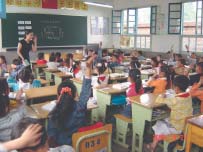
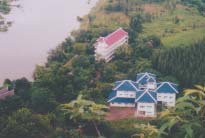
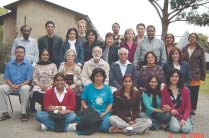
Sathya Sai School Community
Many Sathya Sai Schools rely on a groundswell of Sri Sathya Sai Organisation volunteers for various school functions and employ qualified professional teachers who are often Sai devotees. Many teachers who are not followers of the teachings of Sri Sathya Sai Baba are hired to maintain high standards in the teaching force, and these teachers undergo training in the philosophy and pedagogy of Sathya Saieducation. There is no requirement that Sathya Sai School teachers must become devotees of Sri Sathya Sai Baba.The only mandate is that the teachers exemplify the five human values.
As of summer 2006, the substantial preponderance of the approximately 5,100 children attending Sathya Sai Schools outside India are children of non-Sai devotee families. Most school principals are Sai devotees, and Sai devotee families provide nearly all the food, maintenance and operations, library support, and other non-instructional services at the schools. A majority of teachers in Sathya Sai Schools are not Sai devotees.
Brazil
Most of the students in the five schools do not belong to Sai devotee families, although there is growing interest. Some priority is given to poor families, and the Schools are open to Sai devotee children. Quite a lot of service is given to the Sathya Sai Schools by devotees. Most of the volunteer work is not as teachers, which requires special training and abilities. However, most administrative work (principals, administration) is done by devotees as volunteers, and a number of activities (including maintenance, government permissions, and library operation) are supported by devotees. It is worth noting that many parents volunteer at the Schools for a number of activities.
Canada
The School is served by a core of faithful and reliable day and night volunteers from Sai Centres in the region. In addition, many of the school's outreach programmes receive the organisational expertise and leadership of both adult and youth members of the Organisation. In general, the student population at Sathya Sai Schools is largely from families who are not devotees of Sri Sathya Sai Baba.
Mexico
The student body in one of the Sathya Sai Schools is an example: Our kids are not all poor, not all rich, not all the same religion and not all the same family conditions. We have Mexican natives, abandoned children, girls and boys, kids of divorced parents, boys with some intellectual or physical problems and so on, but this diversity makes the Sathya Sai schools unique, places where kids learn to live and respect and love different people.
United Kingdom
At the Leicester Sathya Sai School, approximately 50 per cent of children and all teaching staff are from Sai families, while at the St. Andrews Sathya Sai School only about 10 per cent of children and 40 per cent of teaching staff are from Sai families. Some help is provided by parents.

Teacher Training and Teaching Resources
Sathya Sai School teachers are expected to exemplify unity in precept and practice of human values in their personal lives to foster more effectively student awareness of, and commitment to, the values. Teachers typically self-select an ISSE for training with necessary approvals, sometimes in another country. One typical example is the Sathya Sai School of Fiji where three of the total of nine teachers received training at the ISSE in Thailand.
Training courses for Sathya Sai School teachers, and numerous ISSE-published teaching resource books, provide direction in integrating education in human values with traditional subject matter.
INSTITUTES OF SATHYA SAI EDUCATION (ISSEs)
Introduction
As has been reviewed earlier, Sri Sathya Sai Baba's teachings on education resulted in the development of Bal Vikas for the children of Sai devotees in India (1969). Sai Spiritual Education (SSE) for the children of devotees in overseas countries soon followed. His subsequent establishment of schools and colleges and of the Institute of Higher Learning in India led to four important developments in many overseas countries:
- Development of Sathya Sai Education in Human Values (SSEHV) Programmes in the community for the children of non-devotees.
- Introduction of SSEHV programmes into mainstream government schools.
- Establishment of Sathya Sai Schools.
- Establishment of Institutes of Sathya Sai Education (ISSEs).
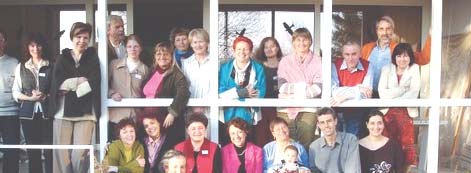
The establishment and management of Sathya Sai Schools that delivered SSEHV in public or private schools required dedicated professionals with specialised skills in many areas. Schools need a governance structure for financial planning, assets development, and management, and expertise for training of teachers, monitoring of educational standards, and accountability to the Ministry of Education and general public.
Establishment of Institutes of Sathya Sai Education outside India
In 1987, the European Sathya Sai Educare Institute was established in Denmark for the training of SSE and SSEHV teachers. This followed the establishment of Institutes of Sathya Sai Education in other countries. Table 1 shows a list of ISSEs around the world.
Functions of ISSE(s)
A major area of activity of an ISSE was to establish and manage Sathya Sai Schools even though in some countries such schools had already been established before the ISSE came into existence. Training of teachers for SSE and SSEHV, development of teaching material for children and teachers, and planning and establishing professional links with State Schools, Teacher Training Colleges, Universities and Ministries of Education were other initial functions of an ISSE. However, since most heads of ISSEs were professional educationists a range of other educational and academic functions were quickly assumed by the ISSEs. Some of these are shown in Table 2. While all ISSEs are involved in training teachers and in planning and/or managing Sathya Sai Schools, different ISSEs have developed additional expertise in several specialised areas.
Establishment and Management of Sathya Sai School(s)
In many countries, an important function of ISSEs is to provide for the educational needs of Sathya Sai Schools. This involves training of professional teachers at the school in SSEHV methodology; inducting new teachers; periodic evaluation of quality of education; employment of staff; financial and asset management; promotion of research; and development, and planning future growth. However, the ISSE alone is not responsible for the mobilisation of funds required for running Sathya Sai Schools. This is partially or solely the responsibility of the Sri Sathya Sai Organisation.
Table 1. Institutes of Sathya Sai Education around the World
| Country | Name of Institute | Date Started |
| Argentina | Instituto Sathya Sai de Educacion en Valores Humanos | 2000 |
| Australia | Institute of Sathya Sai Education | 1996 |
| Brazil | Sathya Sai Institute of Education in Human Values of Brazil | 2000 |
| Chile | Sri Sathya Sai Institute of Chile | 2003 |
| Colombia | Sathya Sai Institute of Education in Human Values of Colombia | 2000 |
| Denmark | ESSE Institute and ESSE Academy | 1987 |
|
Dominican Republic |
Sri Sathya Sai Human Values Institute of Rep. Dominicana | 2004 |
| El Salvador | Sathya Sai Institute of Education in Human Values of El Salvador, C.A. | 1998 |
| Guatemala | Institute Sathya Sai De Valores Humanos De Guatemala | 2004 |
| Hong Kong | Institute of Sathya Sai Education Limited | 1999 |
| India | Institute of Sathya Sai Education, Dharmakshetra, Mumbai | 2000 |
| Ireland | Institute of Sathya Sai Education Ireland Limited | 2005 |
| Japan | Institute of Sathya Sai Education Japan | 1998 |
| México | Sathya Sai Institute of Education of Mexico, A.C. | 2001 |
| New Zealand | Institute of Sathya Sai Education - NZ Inc. | 2000 |
| Philippines | Institute of Sathya Sai Education | 2000 |
| Puerto Rico | Sathya Sai Institute of Education in Human Values of Puerto Rico, Inc. | 2004 |
| South Africa | Institute of Sathya Sai Education | 2002 |
| Thailand | Institute of Sathya Sai Education | 1998 |
| UK | British Institute of Sathya Sai Education (BISSE) | 2003 |
| USA | Sathya Sai Education in Human Values Foundation | 1983 |
| Venezuela | Instituto De Educacion En Valores Humanos De Venezuela (ISEEVHVEN) | 2003 |
| West Indies | Sai Institute of Education West Indies | 2004 |
| Zambia | The African Institute of Sathya Sai Education - TAISSE | 2000 |
Training of Teachers
- Induction Courses. These are run at weekends for the professional teachers and the Sri Sathya Sai devotees involved in SSE. Typical examples are the courses conducted by ESSE as listed in Table 3, but not all Institutes have identical courses.
- Diploma and Other Courses. These are structured courses that extend over several weeks. These courses are designed to give in-depth training in SSEHV philosophy and methodology. An example of the expected knowledge and skills to be acquired by the students from these courses is shown below.
Diploma Course Outline
The Institute of Sathya Sai Education, Mumbai, India:
- This is a two-month residential course open to teachers from Sathya Sai Schools and institutions that are in the process of adopting the Human Values curriculum developed by this Institute. Participants must stay at the Institute’s campus in Dharmakshetra.They are expected to participate in all activities on campus, and must adhere to the ‘Code of Conduct’ for all residents in Dharmakshetra.
- The course requires regular attendance at seminars conducted by the Faculty, active participation in group discussion and workshops, extensive reading of relevant literature, doing homework assignments, and visits to ‘adopted’ schools. Students are expected to visit the ‘adopted’ schools to observe lessons, conduct surveys/interviews, and take practice lessons. Each Diploma student will be expected to submit five assignments and one survey/independent study report. In addition, each student will take five lessons in actual classroom situation. During the course, the student is expected to make two presentations of one-hour duration each on any of the syllabus topics; the presentation will include a 15-minute question-answer session.
Table 2. Functions of Institutes of Sathya Sai Education (ISSEs)
|
Professional Support to Sathya Sai Schools |
Establish and Support Partnerships with Non-Sathya Sai Schools and Institutions | Training and Research Programmes on SSEHV | Self-evaluation ofInstitute Functions |
Assist the Education Wing of Sathya Sai Organization |
|
Review applications and determine the feasibility of new Sathya Sai Schools |
Conduct Seminars and Conferences to create awareness among educa- tionists, professionals, and policy makers on SSEHV philosophy and methodology |
Develop SSEHV training programmes and resources; conduct induction, diploma, advanced diploma, and other courses for professional teachers |
Evaluate Sathya Sai Schools and conduct self-evaluation of its training programmes |
Teacher training for Sai Spiritual Education (SSE) |
| Assist in the selection of teaching staff |
Develop partnership programmes, in accordance with established policy, with public and private schools, national, regional and international bodies |
Produce teaching and learn- ing resources for delivery of SSEHV courses/workshops in non-formal settings |
Evaluate partnership programmes with non- Sathya Sai Schools and institutions (e.g. teacher training colleges and universities) |
Develop and deliver training / workshops for SSE parents and young adults |
| Conduct
periodic inspections for accredi- tation and for ensuring quality standards in meeting character and learning goals in Sathya Sai Schools |
Provide professional guidance to introduce SSEHV in adopted and partnership schools |
Design and implement
observational research and studies on the application of SSEHV in different professions, e.g. in environ- mental education, medical practice, police and defence services, business, law, accounting practice, and sports |
Evaluate
community SSEHV programmes, including parenting programmes |
|
|
Develop and conduct in-service training programmes for teachers |
Conduct community SSEHV programmes, including parenting programmes |
|||
|
Develop programmes for parents |
||||
- The focus of the course is not merely on increasing the participants’ academic knowledge but to enhance understanding of the philosophical foundations and methodology of the curriculum, to assist them to live up to the values professed, and to promote their practical teaching capability.The learning material will broadly cover various areas of knowledge from diverse sources but they will be mainly supported by the philosophy of Sri Sathya Sai Baba’s Integral Education.
Diploma courses are being offered by ISSEs in Thailand, Zambia, South Africa, Australia, India and some Latin American countries. In continental Europe, the Diploma is not a recognised qualification. The intensive training courses that the Academy in Europe runs may extend over several weeks but are not followed by the formal award of a Diploma. The ISSE in UK (BISSE) does not offer any Diploma course but offers SSEHV courses that lead to accreditation by the Open College Network.
- Training of Professional Teachers. Many government schools are in search of help with building expertise in values education and establishing a culture of values. In many countries (for example, Australia, the UK, and New Zealand) values education is being introduced by the Government. However, there is a shortage of skills and expertise in values education generally. Increasingly and in many countries, when the school authorities — a principal or an administrator — realise that the ISSE has the necessary expertise in the pedagogy of SSEHV, they invite the ISSE for the specific purpose of inducting teachers in SSEHV. Such inductions have taken several forms:
- Large numbers of school teachers from many schools attend structured courses of lectures, seminars, and workshops over one or more weekend retreats. This model of professional development is attractive for highly motivated teachers and this has been the general format of teacher training in many countries. The teachers go away inspired. Unfortunately, these induction courses are less attractive for teachers with weak motivation as they are required to attend the training in their spare time. This type of professional development in their spare time does not appeal to many teachers. Furthermore, teachers require regular follow-up workshops and hands-on instructions to maintain their motivation.
- ISSE sends its trainers to train teachers in the government schools where teachers attend during school hours. These are not intensive courses and suffer from a lack of follow-up.
Partnerships in SSEHV in a Whole School Approach
Probably the most successful inductions in SSEHV are through a “whole school approach” in response to specific invitations extended for establishing partnerships in SSEHV by the school authorities. Such partnerships flourish when the principal or the administrator wishes to introduce a culture of human values education often because of identified problems in the school, such as, poor academic performance, discipline problems, bullying, poor school ethos, falling attendances, and general educational failure. In such cases motivation levels for the programme are high and the collective will of all the teachers supports the programme. Experiences from many countries have shown that such partnerships work out best when based on a memorandum of understanding (MOU) and preliminary discussions that delineate mutual responsibilities and obligations. In such MOUs, the ISSE undertakes to provide training of teachers and teaching materials and to monitor the outcome of the SSEHV programme. The school ensures that all teachers, teacher aides, secretarial assistants, and other ancillary staff are able to attend the courses run by the ISSE. The ISSE is able to regularly assess impacts on the children, teachers, parents, school ethos, education, and behavioural outcomes and to modify the programme for maximum benefit on an ongoing basis. These partnerships may continue over many years as the school develops and establishes a progressively richer culture in human values that embraces all activities in the school. Several levels of involvement by the ISSE in schools areas follows:
Partnership Programmes in SSEHV in Latin America
In Latin America, 181 government schools have formed partnerships for SSEHV with the 12 ISSEs. The involvement of ISSEs in Latin American schools with SSEHV programmes are categorised as follows:
- Adopted Schools: a public or private school, which solicits SSEHV programme. Teachers in such a school are trained by the ISSE. In some cases, the ISSE staff gives classes with the regular teachers and, in others such schools they sit in and monitor the delivery of the programme by the regular teachers.
- Partially Adopted Schools: a public or private school in which one or more teachers have obtained the Diploma of the ISSE and are using the SSEHV methodology.
- Pilot Schools: a public school selected jointly by the Ministry of Education and the ISSE to run SSEHV programmes. The ISSE trains the teachers and monitors and evaluates the progress on an ongoing basis.
- Complementary Schools: an out-of-hours school for children and adolescents 5-15 years of age that runs daily and is managed entirely by the ISSE or Sai parents. Such a school is outside the scope of the Ministry of Education. In this school, SSEHV is integrated in a variety of classes, such as art, drama, dance, computer skills, organic gardening, cooking, music, and manual skills. The staff is both volunteers and paid professional teachers.
- Vocational Schools: similar to complementary school except that it is for older adolescents and youth, usually over 20 years of age. In these schools, SSEHV is combined with basic vocational skills, for example reading, writing, cooking, hygiene, and focuses on preparing the students for working as domestics or in jobs requiring simple skills.

Table 3. An Overview of ESSE Courses & Seminars
| Basic Course (2-3 weekends) |
Self-awareness Course (10-12 weekends) |
SSE Teacher Seminars (6-7 weekends) |
Basic Seminar in Adult Education (1-2 weekends) |
Public Speaking Seminars (2-3 weekends) |
|---|---|---|---|---|
| Part 1: The philosophy | Spirituality and Sathya Sai Educare |
Part 1: | For trainers/ instructors/leaders |
Part 1: |
| Overview of the programme |
The human personality | Overview of the five values, the five methods & their inner significance |
Learning process for adults | 1.1 Sharing experiences of challenges in relation to giving a public speech, discourse or lecture |
| The five values & their interrelation |
Sathya Sai's teachings The course includes prepara- tion for individual presenta- tions. It is concluded with presentations of individual essays |
Practical guidelines and examples of |
The role of the facilitator Relations & cooperation Parenting science/ psychology/pedagogies & spirituality Evaluation as self-evaluation Cultural background Leadership How to avoid getting burned out |
1.2 How to structure a presentation, how to use points in a speech, discourse or lecture, and how to involve the audience 1.3 The use of mind mapping 1.4 Body language & use of voice 1.5 Use of audio/visual aids 1.6 Small presentations by participants as per own choice |
| The human personality | Evaluation |
|||
| Unity of all religions | Model lessons | |||
| Part 2: the five methods | Part 2: | Part 2: | ||
The five methods in depth |
||||
| Inner significance, practical guidelines and examples |
Intensive training (a) Presentation of a value, e.g. for parents, colleagues (b) Individual presentations of lesson plans and a model lesson/teaching situation |
Presentation of participants' individual assignments |
||
| Follow-up seminars According to needs |
Follow-up seminars According to needs |
|||
These seminars are basic both for SSE and for SSEHV teachers. ESSE also conducts separate SSEHV seminars and courses for professional teachers and educators. | ||||
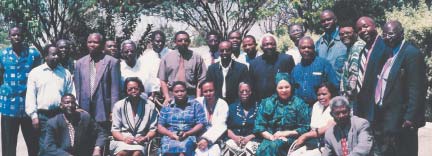
ISSE-Zambia providing training in SSEHV to educationists from African countries
|

United States of America |
Australia
Aboriginal (indigenous) education remains a challenge.The government has provided increasing financial resources and created better educational facilities, which, however, has not resulted in a decrease of the poor achievement levels, high dropout rates and high educational failure in this community. The following is a description of Cherbourg State School, which is a model for Aboriginal education.
Cherbourg State School, Queensland, Australia
- In one such school, a teacher noted that the attendance was poor. Often only five or six children were present in a class of 30, and the children in the afternoon were not the same as the ones in the morning. There was hardly any discipline — the playground was a place of fights. The school had litter all over and the windows were broken. The children had poor social skills, and educationally the school was a failure.
- After a new principal appointed by the school had attended Strengthening Values in Education held in Prasanthi Nilayam in 2000, he invited the Australian Sathya Sai Institute to establish a partnership in SSEHV with his school. The teachers were enthusiastic about the programme and implemented it diligently. The results were remarkable.
- Two years later, research by one of the teachers at the school for a thesis tracked the progress of the children and the school culture. He found that the school was a clean and tidy campus. The children were focused and interested in their studies. They had developed good social skills and were now able to resolve their own differences; school fights were rare. To solve their differences they either negotiated with each other peacefully or took their problem to a teacher rather than resort to fights. Academic levels are now at par with other comparable schools.
Education Queensland (the Government Department of Education) has located a research unit in this school. The school principal was “The Queenslander of the Year” and the teacher who had acted as the human values education coordinator in this school, recognised for her work, was chosen as one of the seven teachers in the State to receive “Teacher of the Year” award. This school is now regarded as a model for Aboriginal education. The principal of the Cherbourg State School has now been promoted as the Director of the Institute of Indigenous Educational Leadership. He has proposed partnerships between the ISSE and dozens of indigenous schools in Australia.
Training of Teachers through Affiliations with Colleges, Universities, and Ministry of Education
In many countries, the ISSEs have established partnerships and alliances with teacher training colleges, universities, and ministries of education for joint programmes. In some countries, this has become a formal link while in others it remains informal. Some examples of formal links are given below.
Australia
The ISSE has developed links through Educare International Ltd. with the Central Queensland University. The Diploma and the Advanced Diploma of the Institute are recognised as acceptable credits towards the degree of Master of Learning Management (MLM) of the Central Queensland University.
Hong Kong
The ISSE is involved in a joint project with the South China Normal University Department of Curriculum and Instruction to conduct research with SSEHV programme in groups of primary schools in Guandong. This is a pilot project. It is envisaged that this will be ground breaking in supporting teachers to develop school-based curriculums permeated with values. This might become a model for the rest of Guandong and other provinces of China.
Sri Lanka
The core concepts of SSEHV have been incorporated into the Values Education of Sri Lanka by the Government.
ISSE as Resource for SSEHV Material
In several countries including Latin America, Taiwan, Japan, Hong Kong and India, the ISSEs act as a resource base for translating, in regional languages, human values education material. This is a vital function in many non-English speaking countries as without translations teachers and educationists will have no access to SSEHV.
Mauritius
There has been significant involvement of the ISSEs in introducing values education to government schools.
Thailand
ISSE-Thailand has developed wide-ranging SSEHV material and is currently working in partnership with the South East Asian Ministers of Education Organisation (SEAMEO) for introducing SSEHV in the state school systems within the region.
United Kingdom
There has been significant involvement of the ISSEs in introducing values education to government schools.
Role of ISSE in Programme Development and Research
Programme development and research go hand-in-hand with education. Many ISSEs have only been established within the last five to six years and yet they have successfully developed and launched significant pilot programmes on a variety of topics. The three ISSEs in Australia,Thailand, and Zambia are conducting research and are involved in developing workshops in collaboration with the United Nations (UN-HABITAT).
Australia
ISSE-Australia has developed a programme for parents and has active projects for the evaluation of SSE in Sai Centres and SSEHV in schools in partnership programmes. It is also conducting research into applications of SSEHV for the educationally-challenged adolescents. Because of interest in Values Education by the Australian Government, ISSE-Australia has embarked on a project to determine the pedagogic challenges that the government school teachers identify for the introduction of values in education into the school system.
Hong Kong
An SSEHV approach to Discipline and Mathematics teaching has been the focus of publications and research of the ISSE in Hong Kong.
India
ISSE-India, established in 2000, has already developed training programmes for the medical profession, police officers, and the corporate sector.
Thailand
ISSE-Thailand has developed — a blueprint for standardisation and accreditation of Sathya Sai Schools around the world through a formal inspection system. ISSE-Thailand has also developed an integrated instructional model for SSEHV based on Intuitive Learning.
SRI SATHYA SAI INTERNATIONAL
CENTRE
FOR HUMAN VALUES
The Sri Sathya Sai International Centre for Human Values (a unit of Sri Sathya Sai Central Trust, Prasanthi Nilayam) was established in New Delhi, India, in March 2001 to provide orientation programmes on Education in Human Values to educationists, professionals, leaders from the corporate world, opinion makers from the media, among others.The Centre provides SSEHV training for principals of selected schools from around India. More than 400 school principals have attended training workshops conducted by the Centre so far. Sri Sathya Sai Baba’s Mahavakya on Leadership is used as the principal source book in these workshops.
The Centre operates a Sathya Sai School for underprivileged children and school dropouts, providing SSEHV activities in a multi-age setting. The Centre provides an outreach programme to Delhi University students.The programme hosts debates and inter-college competitions in poster making, slogan writing, collage-making, singing, and reading on topics related to SSEHV.For example, a debate was held in November, 2005 on “No civilisation can prosper without human values.”The Centre has organised at regular intervals, other SSEHV orientation courses for different segments of society. These include seminars for senior officers from the Indian Railways, Indian Police Service, Indian Administrative Service and Indian Armed Forces. It also plans to conduct seminars for senior executives from the corporate sector, and also for writers and publishers.The Centre invites scholars, opinion-makers and eminent personalities such as the Dalai Lama to speak on human values.
The Centre has a well-equipped library and runs a bookshop for the sale of books published by Sri Sathya Sai Books and Publications Trust.The Centre publishes a bi-monthly newsletter “Sai International” and produces other educational material on education in human values.

References
Chibber, M.L., (2005), Sai Baba’s Mahavakya on Leadership: Book for Youth, Parents and Teachers, Sri Sathya Sai Books and Publications Trust, Puttaparthi, Andhra Pradesh, India
Institute of Sathya Sai Education, Thailand, (2000), Sathya Sai Schools around the World, Institute of Sathya Sai Education, Bangkok,Thailand.
Institutes of Sathya Sai Education, Thailand, (2000), Prospectus (2000), Institute of Sathya Sai Education, Bangkok, Thailand.
Jareonsettasin, T., (1998), Sathya Sai Meditation on the Light, Institute of Sathya Sai Education, Bangkok, Thailand.
Jumsai, A., (1997), Integration of Human Values in Sciences and Mathematics, Institute of Sathya Sai Education, Bangkok, Thailand.
Jumsai, A. and Burrows, L., (1991), Sathya Sai Education in Human Values Handbooks for Teachers, Sathya Sai Foundation of Thailand, Bangkok,Thailand.
Naicker, S., (2002), Leadership and Management of Sathya Sai Schools, The African Institute of Sathya Sai Education, Ndola, Zambia.
The African Institute of Sathya Sai Education, (1994), Starting and Managing Sathya Sai Schools: The Zambian Experience, Ndola, Zambia (unpublished manuscript).
The African Institute of Sathya Sai Education, (1999), Learning to Learn: Sai Lessons at the Sai School in Ndola, Africa, The African Institute of Sathya Sai Education, Ndola, Zambia, Africa.
The African Institute of Sathya Sai Education, (2005), The African Institute of Sathya Sai Education Booklet, The African Institute of Sathya Sai Education, Ndola, Zambia, Africa.